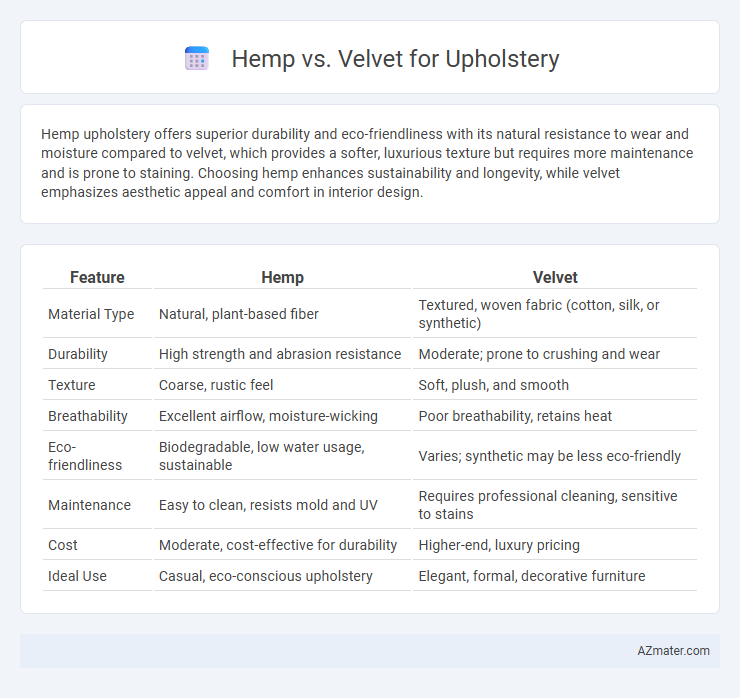Hemp upholstery offers superior durability and eco-friendliness with its natural resistance to wear and moisture compared to velvet, which provides a softer, luxurious texture but requires more maintenance and is prone to staining. Choosing hemp enhances sustainability and longevity, while velvet emphasizes aesthetic appeal and comfort in interior design.
Table of Comparison
| Feature | Hemp | Velvet |
|---|---|---|
| Material Type | Natural, plant-based fiber | Textured, woven fabric (cotton, silk, or synthetic) |
| Durability | High strength and abrasion resistance | Moderate; prone to crushing and wear |
| Texture | Coarse, rustic feel | Soft, plush, and smooth |
| Breathability | Excellent airflow, moisture-wicking | Poor breathability, retains heat |
| Eco-friendliness | Biodegradable, low water usage, sustainable | Varies; synthetic may be less eco-friendly |
| Maintenance | Easy to clean, resists mold and UV | Requires professional cleaning, sensitive to stains |
| Cost | Moderate, cost-effective for durability | Higher-end, luxury pricing |
| Ideal Use | Casual, eco-conscious upholstery | Elegant, formal, decorative furniture |
Introduction to Hemp and Velvet Upholstery
Hemp upholstery offers durability, sustainability, and natural resistance to wear, making it an eco-friendly choice for furniture covering. Velvet upholstery, known for its luxurious texture and rich appearance, provides a soft, plush feel that enhances aesthetic appeal. Both materials cater to different design preferences, with hemp excelling in strength and eco-conscious appeal, while velvet excels in elegance and tactile comfort.
Material Composition and Characteristics
Hemp upholstery fabric is made from the fibers of the Cannabis sativa plant, known for its strength, durability, and natural resistance to wear and tear, making it ideal for high-traffic furniture. Velvet upholstery, typically composed of cotton, polyester, or silk fibers, features a dense pile that creates a soft, luxurious texture with a slight sheen, offering both aesthetic appeal and comfort. While hemp excels in sustainability and breathability, velvet provides superior softness and an elegant appearance, influencing their suitability for different upholstery needs.
Durability and Longevity Comparison
Hemp upholstery offers exceptional durability due to its tightly woven fibers, making it resistant to wear, tear, and fading over time, ideal for high-traffic areas. Velvet, while luxurious and soft, tends to show signs of wear more quickly with visible crushing and pile wear, requiring more maintenance to maintain its appearance. In terms of longevity, hemp outperforms velvet by providing a sturdier fabric that withstands daily use with minimal degradation.
Comfort and Texture Differences
Hemp upholstery offers a coarse, natural texture that becomes softer with use, providing durability and breathability, ideal for those seeking eco-friendly and sturdy fabric options. Velvet upholstery features a smooth, plush surface with a luxurious feel, delivering superior softness and a rich texture that enhances comfort and visual appeal. The choice between hemp and velvet hinges on desired tactile experience and maintenance preferences, with hemp favoring rustic durability and velvet prioritizing softness and elegance.
Maintenance and Cleaning Requirements
Hemp upholstery offers high durability with natural resistance to stains and mold, requiring only regular vacuuming and occasional spot cleaning with mild soap and water to maintain its appearance. Velvet demands more delicate care due to its plush texture, needing frequent gentle brushing to prevent matting and professional cleaning to avoid water marks and preserve its softness. Hemp's moisture-wicking properties reduce the risk of mildew buildup, while velvet's dense fibers are more prone to trapping dust and dirt, necessitating careful maintenance routines.
Environmental Impact and Sustainability
Hemp fabric for upholstery is highly sustainable due to its rapid growth cycle, requiring minimal water, pesticides, and fertilizers, which significantly reduces environmental impact compared to conventional materials. Velvet, often made from synthetic fibers, involves energy-intensive production processes and non-biodegradable components that contribute to pollution and resource depletion. Choosing hemp upholstery supports eco-friendly manufacturing and promotes a biodegradable, low-impact textile alternative.
Color and Design Versatility
Hemp upholstery offers a natural, earthy color palette with muted greens, browns, and tans, providing a rustic and organic aesthetic ideal for eco-friendly interiors. Velvet upholstery excels in a vast array of rich, vibrant colors and finishes, from deep jewel tones to soft pastels, enabling high design versatility and dynamic visual impact. The texture and sheen of velvet enhance color depth and pattern expression, making it a preferred choice for luxurious and customizable design schemes.
Cost and Affordability Analysis
Hemp upholstery fabric generally offers a cost-effective and sustainable option, with prices averaging between $8 to $15 per yard, making it affordable for eco-conscious consumers. Velvet tends to be pricier, ranging from $20 to $60 per yard depending on quality and fiber content, which can significantly increase overall upholstery expenses. When balancing durability and budget, hemp provides a more affordable, long-lasting alternative for upholstery projects compared to the luxurious but costly velvet.
Best Applications and Suitable Spaces
Hemp upholstery excels in durability and breathability, making it ideal for high-traffic areas like living rooms and family rooms where long-lasting fabric is essential. Velvet offers a luxurious, soft texture that enhances comfort and aesthetics, best suited for formal spaces such as lounges, bedrooms, and upscale offices. Choosing between hemp and velvet depends on the desired balance of ruggedness versus elegance, with hemp favored for eco-friendly, rustic designs and velvet for plush, sophisticated interiors.
Final Verdict: Which is Better for Upholstery?
Hemp offers remarkable durability, natural resistance to wear, and eco-friendly properties, making it an ideal choice for upholstery in high-traffic areas. Velvet provides a luxurious feel and elegant appearance but requires more maintenance due to its delicate fabric composition and susceptibility to stains. For long-lasting, sustainable upholstery, hemp is the superior option, while velvet suits spaces prioritizing aesthetic appeal over heavy use.

Infographic: Hemp vs Velvet for Upholstery
 azmater.com
azmater.com